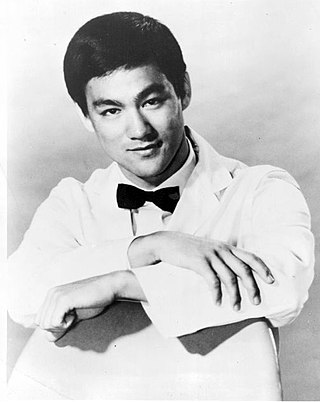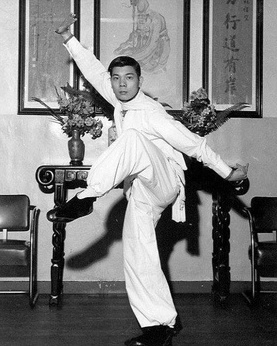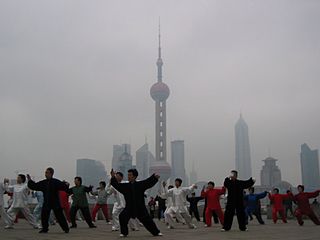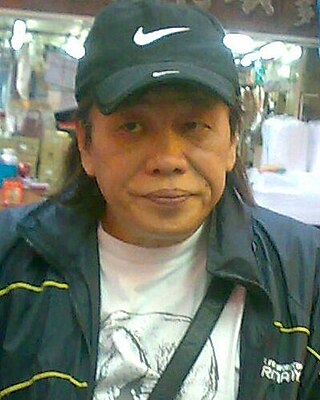Related Research Articles

Bodhidharma was a semi-legendary Buddhist monk who lived during the 5th or 6th century CE. He is traditionally credited as the transmitter of Chan Buddhism to China, and is regarded as its first Chinese patriarch. According to a 17th-century apocryphal story found in a manual called Yijin Jing, he began the physical training of the monks of Shaolin Monastery that led to the creation of Shaolin kungfu. He is known as Dámó in China and as Daruma in Japan. His name means "dharma of awakening (bodhi)" in Sanskrit.

Shaolin Monastery, also known as Shaolin Temple, is a renowned monastic institution recognized as the birthplace of Chan Buddhism and the cradle of Shaolin Kung Fu. It is located at the foot of Wuru Peak of the Songshan mountain range in Dengfeng County, Henan Province, China. The name reflects its location in the ancient grove of Mount Shaoshi, in the hinterland of the Songshan mountains. Mount Song occupied a prominent position among Chinese sacred mountains as early as the 1st century BC, when it was proclaimed one of the Five Holy Peaks. It is located some 48 km (30 mi) southeast of Luoyang, the former capital of the Northern Wei Dynasty (386–534), and 72 km (45 mi) southwest of Zhengzhou, the modern capital of Henan Province.

Bruce Lee was a Hong Kong-American martial artist and actor whose career spanned Hong Kong and the United States. He was the founder of Jeet Kune Do, a hybrid martial arts philosophy drawing from different combat disciplines that is sometimes credited with paving the way for modern mixed martial arts (MMA). Lee is considered by some commentators and martial artists to be the most influential martial artist of all time and a pop culture icon of the 20th century, who bridged the gap between East and West. He is credited with promoting Hong Kong action cinema and helping to change the way Chinese people were presented in American films.

Shaolin kung fu, also called Shaolin Wushu, or Shaolin quan, is one of the oldest, largest, and most famous styles of wushu, or kung fu of Chan Buddhism. It combines Chan philosophy and martial arts. It was developed in the Shaolin Temple in Henan province, Greater China during its 1500-year history. Popular sayings in Chinese folklore related to this practice include "All martial arts under heaven originated from Shaolin" and "Shaolin kung fu is the best under heaven," indicating the influence of Shaolin kung fu among martial arts. The name Shaolin is also used as a brand for the so-called external styles of kung fu. Many styles in southern and northern China use the name Shaolin.
Kung Fu is an American action-adventure martial arts Western drama television series starring David Carradine. The series follows the adventures of Kwai Chang Caine, a Shaolin monk who travels through the American Old West, armed only with his spiritual training and his skill in martial arts, as he seeks Danny Caine, his half-brother.

Chinese martial arts, often called by the umbrella terms kung fu, kuoshu or wushu, are multiple fighting styles that have developed over the centuries in Greater China. These fighting styles are often classified according to common traits, identified as "families" of martial arts. Examples of such traits include Shaolinquan (少林拳) physical exercises involving All Other Animals (五形) mimicry or training methods inspired by Old Chinese philosophies, religions and legends. Styles that focus on qi manipulation are called internal, while others that concentrate on improving muscle and cardiovascular fitness are called external. Geographical association, as in northern and southern, is another popular classification method.

Shaolin Soccer is a 2001 Hong Kong sports comedy film directed by Stephen Chow, who also stars in the lead role. The film revolves around a former Shaolin monk who reunites his five brothers, years after their master's death, to apply their superhuman martial arts skills to play soccer and bring Shaolin kung fu to the masses.
The following outline is provided as an overview of and topical guide to martial arts:

In its broadest sense, Northern Shaolin is the external martial arts of Northern China, referring to those styles from the Northern Shaolin Monastery in Henan and specifically to the style practice by Gù Rǔzhāng, the Sōngshān Shí Lù Shàolínquán (嵩山十路少林拳) / Song Mountain Ten Road Shaolin Boxing.

Wong Jack-man was a Chinese martial artist and teacher. He was best known for his controversial duel with Bruce Lee in 1964.

There are hundreds of different styles of Chinese martial arts, each with their own sets of techniques and ideas. The various movements in kung fu, most of which are imitations of the fighting styles of animals, are initiated from one to five basic foot positions: normal upright posture and the four stances called dragon, frog, horse riding, and snake. The concept of martial arts styles appeared from around the Ming dynasty (1368–1644). Before the Ming period, martial skills were commonly differentiated mainly by their lineage. There are common themes among these styles which allow them to be grouped according to generalized "families", "fractions", "class", or "schools" of martial art styles. There are styles that mimic movements from animals, or otherwise refer or allude to animals or mythical beings such as dragons, and others that gather inspiration from various Chinese philosophies or mythologies. Some deeply internal styles tend to focus strongly on practice relating to harnessing of qi energy, while some more-conspicuously external styles tend more to display skills and abilities in competition or exhibition.

Lam Sai-wing was a Hung Gar martial artist. He was a student of the Chinese martial artist, acupuncturer and folk hero of Cantonese ethnicity, Wong Fei-hung.

Shi Yongxin is the current abbot of the Shaolin Temple. He is the thirteenth successor after Shi Xingzheng. He is the Chairman of the Henan Province Buddhists Association, a representative of the Ninth National People's Congress and also one of the first Chinese monks ever to get an MBA degree.

Bruce Liang is a Hong Kong martial artist and actor who has appeared in many Hong Kong martial arts movies. He often appeared billed as "Bruce Leung", "Bruce Liang", "Bruce Leong", or "Bruce Leung Siu-lung", and is thus generally grouped among the Bruce Lee clones that sprang up after Lee's death in the subgenre known as Bruceploitation.
The origins of Asian martial arts are diverse and scattered, having roots in various regions of Asia. Various Asian martial arts reference the study of animal movements as inspiration for martial arts techniques.
The Bruce Lee Library is composed of books written by or about Bruce Lee (1940-1973), famous Hongkongese and American martial artist, philosopher, author, instructor of martial arts, actor, filmmaker and screenwriter.
Casanova Wong, is a Korean film actor and martial artist born in 1945 Gimje, South Korea. An expert in tae kwon do, he is a leg-fighter, and is well known for his spin kicks and was nicknamed "The Human Tornado" in the Republic of Korea Army. He made many appearances in martial arts movies but is most remembered for his role as Cashier Hua in Warriors Two, where he starred alongside Sammo Hung, with whom he worked several times. Other films included Story of Drunken Master and Rivals of the Silver Fox. One of Wong's last notable movie appearances was as Kang-ho in the 1994 Korean movie Bloody Mafia.
This martial arts timeline is designed to help describe the history of the martial arts in a linear fashion. Many of the articles for particular styles have discussions of their history. This article is designed to help visualize the development of these arts, to help better understand the progression of the separate styles and illustrate where they interrelate.
The Real Shaolin is a 2008 documentary film directed by Alexander Sebastien Lee. The Real Shaolin follows the story of two Chinese and two Westerners who journey to the Shaolin Temple in China, inspired by the legends portrayed in Kung Fu movies with Bruce Lee and Jet Li. In the course of excruciating martial arts training, their fantasies to become Kung Fu warriors collide with harsh reality, as the Shaolin Temple is the ultimate test for martial artists from all over the world.

Shi Yan Ming is a 34th generation Shaolin warrior monk, teacher and actor, best known as the founder of the USA Shaolin Temple. Trained at the Shaolin Temple in Henan, People's Republic of China (PRC) since the age of five, Shi Yan Ming came to the United States in 1992, before opening the USA Shaolin Temple in Manhattan, where he has taught hundreds of students, including numerous celebrities. He has made various media appearances in television, film and print, including National Geographic, PBS, History, Time magazine, and the 1999 American samurai action film, Ghost Dog: The Way of the Samurai.
References
- 1 2 Blankenship, Bill (2005-04-13). "A Shaolin Taught". Topeka Capital-Journal. Bell & Howell Information and Learning Company.
- 1 2 Feng, Ying-biao 馮應標 (2020-11-27). "李小龍的洋血統". Master-Insight (in Chinese (Hong Kong)). Retrieved 2022-03-13.
- 1 2 de Bertodano, Helena (2007-04-03). "Ready for the iron crotch, Grasshopper?;Men". The Times. Times Newspapers Limited.
- ↑ "American Shaolin: Craig Ferguson". YouTube .
- ↑ Polly, Matthew (December 1, 2003). "Beijing Cabbies: China's Talking Heads". Slate Magazine. Retrieved October 26, 2021.
- ↑ Polly, Matthew (May 3, 2004). "Topeka's Dubious Achievement Award". Slate Magazine. Retrieved October 26, 2021.
- 1 2 Polly, Matthew (2007). American Shaolin : flying kicks, Buddhist monks, and the legend of iron crotch : an odyssey in the new China. New York: Gotham Books. ISBN 978-1-59240-262-5. OCLC 70866948.
- ↑ "American Shaolin: Flying Kicks, Buddhist Monks, and the Legend of Iron Crotch: An Odyssey in the New China". American Library Association. Retrieved 2021-03-08.
- ↑ American Library Association (2008-01-15). "Best Books for Young Adults 2008". Young Adult Library Services Association (YALSA). Retrieved 2021-03-08.
- ↑ American Library Association (2008-01-14). "2008 Alex Awards". Young Adult Library Services Association (YALSA). Retrieved 2021-03-08.
- ↑ "American Shaolin: Flying Kicks, Buddhist Monks, and the Legend of Iron Crotch: An Odyssey in the New". American Library Association. Retrieved 2021-03-08.
- ↑ American Library Association. "Outstanding Books for the College Bound and Lifelong Learners | Awards & Grants". Young Adult Library Services Association. Retrieved 2021-03-08.
- ↑ "American Shaolin: Flying Kicks, Buddhist Monks, and the Legend of Iron Crotch: An Odyssey in the New China | Awards & Grants". American Library Association. Retrieved 2021-03-08.
- ↑ "Popular Paperbacks for Young Adults | Awards & Grants". American Library Association. Retrieved 2021-03-08.
- 1 2 Polly, Matthew (2012). Tapped out : rear naked chokes, the octagon and the last emperor : an odyssey in mixed martial arts. New York: Gotham. ISBN 978-1-59240-619-7. OCLC 801605401.
- ↑ Polly, Matthew (2018). Bruce Lee : a life (first ed.). New York, NY: Simon & Schuster. ISBN 978-1-5011-8762-9. OCLC 1031407919.
{{cite book}}: CS1 maint: date and year (link) - ↑ Khatib, Joumana (2019-05-30). "New in Paperback: 'Bruce Lee,' 'Fruit of the Drunken Tree' (Published 2019)". The New York Times. ISSN 0362-4331 . Retrieved 2021-03-08.
- ↑ "Bruce Lee: A Life". Publishers Weekly. Retrieved 2021-03-08.
- ↑ "Bruce Lee: A Life". IndieBound.org. 2020. Retrieved June 29, 2021.
- ↑ "Crítica de Libros de Cine. Bruce Lee: Una Vida". CineNuevaTribuna.es. 2020. Retrieved Jun 29, 2021.
- ↑ "Cultura. 80 años del nacimiento de Bruce Lee, el pandillero que rompió el techo de cristal amarillo de Hollywood". TheObjective.com. 2020. Retrieved June 29, 2021.